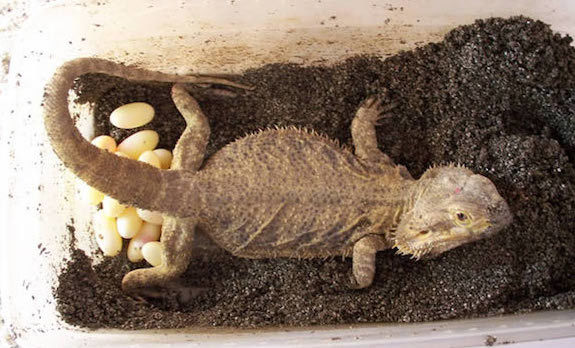As a reptile lover, I wanted to pet a bearded dragon for so long. But I think keeping a pet is not an easy task. It becomes your responsibility to take care of your cute little friend.
So, I researched bearded dragons’ behavior, eating habits, and their reproductive process. I came to know some interesting facts about breaded dragon mating behavior.
Now, Let’s jump into the article and explore the facts for the successful breeding of your cute reptile.
Understanding Bearded Dragon Mating Behavior
The bearded dragon’s mating season starts in early spring and may extend to the summer. Male bearded dragons show dominance in their mating behavior. Bearded dragons mating may appear very aggressive. Head bobbing and arm weaving are common courtship behaviors for male and female dragons. The male dragon bites her neck to get into the perfect position. If the female is receptive to his behavior, she will stay still and allow the male to mate. Set up a perfect enclosure for mating bearded dragons. The perfect environment will also ensure healthy breeding.
What Are the Mating and Courtship Behaviors of Bearded Dragons?

Courtship
Male bearded dragons usually initiate courtship rituals to attract females. They display their dominance by head-bobbing, arm-waving, and puffing up their throats to show off their beards. These displays are meant to impress the female and establish the male’s suitability as a mate.
Head bobbing
Head-bobbing is a common behavior among male bearded dragons during courtship. The male will repeatedly bob its head up and down, sometimes accompanied by arm-waving. This behavior is a way for the male to signal its intentions and establish dominance.
Arm-waving
Arm-waving is another behavior observed in male bearded dragons during courtship. The male will lift one of its front legs and wave it in a circular motion. This behavior is thought to attract the female’s attention and is often performed in combination with head-bobbing.
Feet stomp
Finally, the male dragon starts stomping, chasing the female dragon by enclosing her. Then he starts biting her neck as a mating process of bearded dragons.
Femoral Pores
Male bearded dragons have femoral pores located on the underside of their thighs. These pores secrete waxy substances used in scent marking and can become more prominent when the dragon is ready to mate.
Cloacal Swelling
In both male and female bearded dragons, the cloaca (the vent used for waste elimination and reproduction) can become slightly swollen when they are nearing the mating season.
Appetite Changes
Some bearded dragons may experience changes in appetite during the breeding season. Males might show decreased interest in food, while females may display increased appetite due to egg development.
Female bearded dragon mating Response
The female bearded dragon will begin to make a response by bobbing her head up and down, curling her tail, and twirling her arm in a circular motion.
What is the Mating Season for Bearded Dragons?
The mating season of bearded dragons can vary depending on various factors, including geographic location, climate, and individual health. In Australia, the native land of bearded dragons, mating season starts from March up to September.
Wild bearded dragons typically experience a breeding season during the warmer months when environmental conditions are optimal for reproduction.
However, for bearded dragons kept as pets, mating and fertilization happen throughout the year due to the controlled environment provided.
In captivity, artificial lighting and temperature control mimic the summer conditions to breed bearded dragons any time of the year. So, in this condition, mating happens frequently.
Many breeders think offering a brumation period(drop the temperature low for a particular time) before mating would be better for bearded dragons.
Brumation is not necessary for breeding, but it may help stimulate the reproductive hormones and increase the chances of successful mating.
When Do Bearded Dragons Become Sexually Mature?
Bearded dragons reach sexual maturity around 10 to 12 months, depending on their size and health. A sexually mature bearded dragon’s length may reach 16 to 24 inches, and its weight can be 380 to 510 grams.
A healthy adult bearded dragon should weigh between 450 to 550 grams or more, with males being slightly larger than females
It is advisable to wait until both the male and female are at least one year old and have reached their full adult size before breeding them. If you try to breed an underweight or immature bearded dragon can cause health problems and complications for both the parents and the offspring.
Generally, a male bearded dragon may become sexually mature earlier than a female. So, it is recommended not try to breed your female bearded dragon before 18 months or 350 grams of weight.
How to Determine the Sex of a Male and Female Bearded Dragon

Soon after birth, it is hard to identify if the beaded dragon is male or female. But experienced breeders can identify it after four months to one year. But if you are curious to know the sex of your little reptile, you can check with the methods below.
- The most common method is to look at the hemipenal bulges on the underside of the tail near the anus. Males have two prominent bulges side by side, while females have one smaller bulge in the center underneath their tail.
- Another method is to look at the size and shape of the claws, tail, and spurs (small bumps on the back legs). Males have larger claws, thicker tails, and more developed spurs than females.
- Femoral pores are another way to recognize if your baby bearded dragon is male or female. Femoral pores are the spot where sexually mature adult bearded dragon secretes pheromones. Male and female femoral pores look different from each other. Male pores are more significant compared to female pores. On the other hand, the female tends to have fewer pores with noticeable color.
- The cloacal opening is another way to determine a bearded dragon’s sex. Female bearded dragons tend to have narrower cloacal openings than males. But before determining this factor, you need to consider the bearded dragon’s body size.
Lastly, I prefer the best way to confirm the sex of a bearded dragon is to consult a vet or a reptile specialist who can perform a cloacal probe or a genetic test.
Recognizing Sexual Dimorphism
Size and Body Shape
Adult male bearded dragons are typically larger and bulkier than females. They have broader heads, more enormous jowls, and a muscular build. Females, on the other hand, are generally smaller and have a slimmer body shape.
Head Shape
Male bearded dragons often have larger heads and more pronounced triangular-shaped heads than females. Their heads may also have more distinct crests and bumps.
Pore Presence
Males have prominent femoral pores located on the underside of their thighs. These pores secrete waxy substances used in scent marking. Females may have smaller or less noticeable pores or lack them altogether.
Hemipenal Bulges
Male bearded dragons have two bulges at the base of their tail, which are the hemipenes used for reproduction. These bulges are usually more visible in sexually mature males. Females do not have these bulges.
Cloacal Distance
The distance between the cloaca (the vent used for waste elimination and reproduction) and the tail’s base can indicate sex. In males, this distance is typically greater than in females.
Behavioral Cues
While not a reliable method for determining sex, males tend to display more dominant and territorial behaviors, such as head bobbing, arm waving, and beard puffing. Females may exhibit submissive behavior. Female bearded dragons can lay eggs if they are gravid (carrying eggs).
Is Determining the Sex Important for Bearded Dragon Breeding
Knowing the sex of bearded dragons is crucial for successful breeding. Breeding requires a male and female pairing, so if you have a specific breeding goal or want to prevent unintended breeding, accurately identifying the sex of your dragons is essential. You can also easily identify the health issues of your bearded dragon with their sex.
Pairing and Preparing for Breeding
Age and Health
Ensure that both the male and female bearded dragons are mature and in good health before attempting to breed them. You can get a hint from their behavior if your bearded dragon is ready to mate. You should wait until at least 18 months old and have reached their adult size.
Pairing
Introduce the male and female bearded dragons gradually. Start by placing their enclosures near each other so they can see and smell each other without direct contact. Monitor their behavior closely to ensure they are comfortable with each other. Once they are accustomed to each other’s presence, you can move on to the next step.
Preparing the Enclosure
When the breeding pair accept each other as partners now you can create a suitable breeding enclosure for the dragons. It must be spacious enough for both dragons. Ensure it has adequate hiding spots, basking areas, and a nesting box. The nesting box should be filled with a suitable substrate, such as vermiculite or sand, to provide a place for the female bearded dragon lay eggs safely.
Temperature and Lighting
Maintain proper temperature and lighting conditions in the breeding enclosure. Provide a basking spot with a temperature around 100-110°F (37-43°C) and a cooler area around 80-85°F (27-29°C). Ensure there is a proper UVB light source to support their overall health.
Diet and Supplementation
Feed the bearded dragons a well-balanced diet consisting of insects, leafy greens, and vegetables. It’s important to ensure they receive proper calcium and vitamin supplementation to support reproductive health. Consult a reptile veterinarian for specific dietary recommendations.
Observation and Courtship:
Once the bearded dragons are in the breeding enclosure, closely observe their behavior. The male dragon will chase the female. They may display head bobbing, arm waving, and darkening of the beard to show courtship behavior. The female may exhibit a receptive posture, known as “back arching,” where she lifts her tail to the side when approached by the male.
Mating
If the female displays receptive behavior, introduce the male into her enclosure. Observe the mating process, which may involve the male biting the back of the female’s neck or gripping her sides. Mating can occur multiple times over several days.
Egg Laying

After successful mating, provide the female with a suitable nesting box filled with a damp substrate. The female will dig a hole and lay her eggs in the hole. Ensure the nesting box remains moist but not wet. After egg-laying, carefully remove the eggs and transfer them to an incubator or suitable environment for proper development.
It’s essential to conduct thorough research and consult with experienced reptile breeders or veterinarians to ensure you have a complete understanding of the breeding process for bearded dragons.
Mating Ritual and Egg-Laying Process
Once the Female bearded dragon ready to mate, she will sit in front of the male dragon and try to seduce him. In response, the male will roam around her and try to find a position to climb her.
- After getting into her male bearded dragon, try to insert his hemipenis into the cloaca of the female bearded dragon. Once it is done female dragon will lift her head and indicate to leave her.
- Sperm is transferred from male’s hemipenis into the female’s cloaca. It travels to oviducts from there. Then the sperm combines with the eggs(ova) released by the female.
- After 4-6 weeks after mating, the fertilized egg develops and is eventually laid by the female.
Bearded dragons may engage in multiple mattings, particularly when multiple males are present. This behavior allows for increased genetic diversity and ensures successful fertilization.
Multiple matings may occur within a breeding season, and females can store sperm for several clutches of eggs. So, in this way bearded dragons can lay eggs even from previous matings.
Nesting & Egg Laying Behavior
When it is time to lay eggs, female dragons tend to be lethargic and lack energy. They sleep all day under the lamp. Their belly also looks bulky when it is filled with eggs. Bearded dragons look for a space to lay eggs from the last few weeks of her pregnancy. So, you must make a proper nesting space for your bearded dragon within this period.
- You can make a nesting box by pouring it with moist substrates like soil or sand.
- Make sure the nesting box is spacious enough for your bearded dragon.
- Increase the humidity of the enclosure.
- Give your little friend a calm & quiet environment and maintain a well-balanced diet.
- Don’t open the incubator frequently.
Incubation & Egg Hatching

The incubation of bearded dragon eggs is an essential process to ensure the successful hatching of the eggs. The bearded dragon eggs take time to hatch. The incubation period lasts around 50 to 80 days. You can follow some simple steps to make sure proper incubation.
- First, Use a reliable and accurate egg incubator specifically designed for reptiles. Set the temperature to around 82-86°F (28-30°C) for most bearded dragon species. Ensure the humidity is maintained at around 70% throughout the incubation period.
- Gently remove the eggs from the nesting area and safely place them in the incubator box. Check if the eggs are fertile. There is no use in incubating the infertile eggs. Even they can attract bacteria.
- Arrange the eggs with a few inches gap among them.
- After properly organizing the eggs, it is time to move them to the incubator. Be careful while you move the eggs. Make sure to set the temperature correctly.
- Now, keep your eye on the eggs to make sure they are okay. If any eggs seem to be rotten or moldy, throw them up.
Remember, bearded dragon breeding and egg incubation require careful attention and knowledge. So, it is recommended to do further research and consult with experienced reptile breeders or veterinarians if you are still an amateur.
Conclusion
Bearded dragons mating season starts from early summer or spring. So, you must prepare a pair of bearded dragons if you want to breed your bearded dragon. Consider their age, health and behavior before proceeding. Closely monitor their mating behavior the whole time, maintain proper nesting, and care for healthy breeds.
FAQ
How long does it take for the bearded dragon lay their eggs?
It can take 4to 6weeks to lay eggs. Bearded dragons lay eggs in clutches. Generally, around 20 eggs make one clutch.
How do you know if your bearded dragons are breeding?
They will bob their head and weave their arms. The male dragon’s beard gets darkened, and they stomp their feet to get the attention of the opposite sex. Sometimes they can also twitch their tails to express their courtship behavior.
How long does it take for the bearded dragon lay their eggs?
It can take 4to 6weeks to lay eggs. Bearded dragons lay eggs in clutches. Generally, around 20 eggs make one clutch.
How do you know if your bearded dragons are breeding?
They will bob their head and weave their arms. The male dragon’s beard gets darkened, and they stomp their feet to get the attention of the opposite sex. Sometimes they can also twitch their tails to express their courtship behavior.
Can Bearded Dragons Mate With Siblings?
No. It is not recommended to breed between siblings. It can cause birth defects or other health issues. Some experts also suggest there is nothing to worry about breeding between brother and sister. But you should consult with an expert before doing that.
How do bearded dragons act when pregnant?
A gravid bearded dragon will gain weight faster, and it will also increase her appetite. You can also notice her belly looks bigger than before. You can also find some behavioral changes. She looks agitated and nervous all the time.
Hugues Beaufrere is the Exoticpetia’s senior writer and reptile expert. He has been fascinated by reptiles and monkeys since he was a kid and had years of experience in herpetology and primatology. He has cared for various kinds of Monkeys, Lizards and Reptiles and loves to share his knowledge and passion with others.


